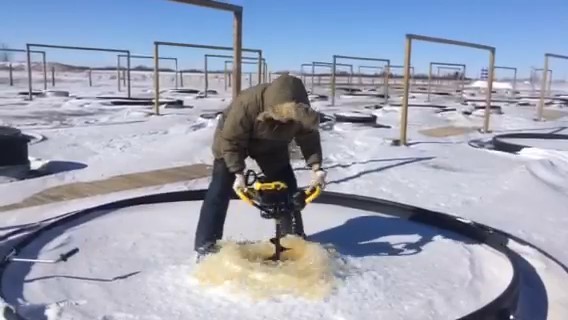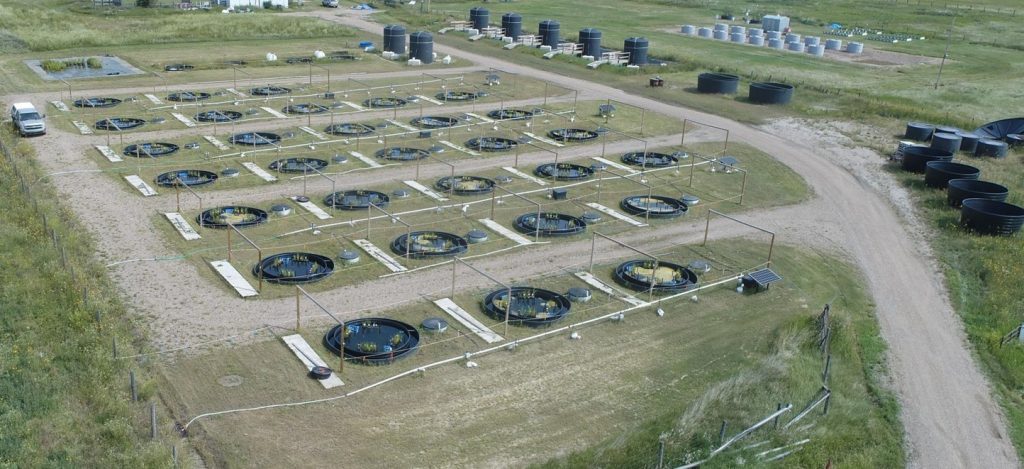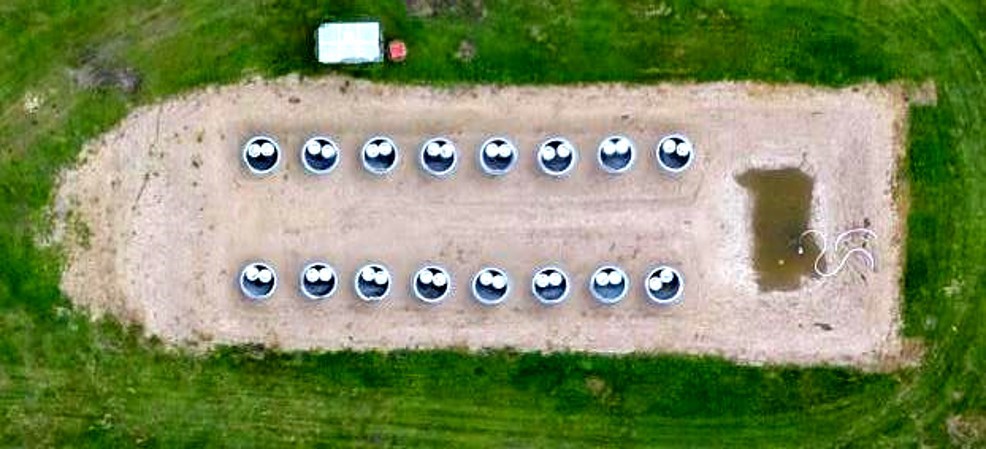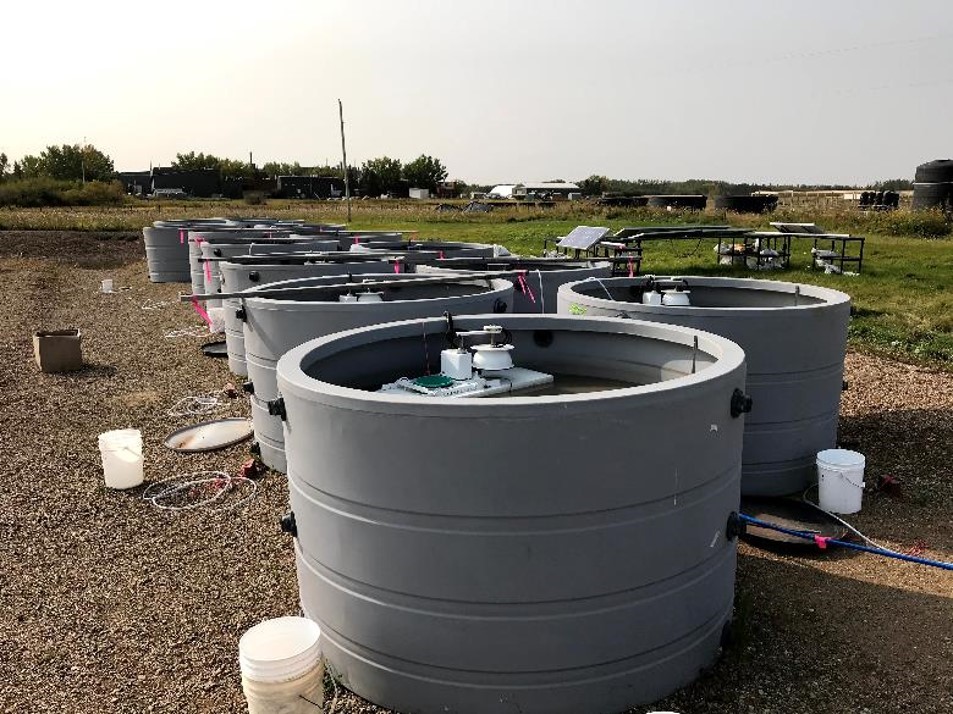PO Bag 4000
Hwy 16A & 75 Street
Vegreville, Alberta, Canada, T9C 1T4
Brian Eaton, Manager, Environmental Impacts
Please login or request access to view contact information.
Jim Davies, Researcher, Environmental Impacts
Please login or request access to view contact information.
1) AQUATIC MESOCOSMS
Our facility includes 30 outdoor polyethylene in-ground mesocosms (14 m3 operating volume each) nested within larger containment tanks.
Each mesocosm is approximately 1.5 m deep and 3.6 m in diameter. Overflow protection is provided by drainage into below-ground holding tanks. The mesocosms are allowed to freeze each winter, resulting in ~ 0.5 m of liquid water maintained under ~ 1.0 m of snow and ice. The water layer allows a range of taxa to persist across consecutive years, enabling multi-year studies.
A network of gravel roads allows large vehicles to access the mesocosms. Wooden walkways and vertical posts support the staging and deployment of instrumentation, sampling materials, and other gear.
Evaporative losses are offset by potable water stored in a pair of large (25 m3) above-ground tanks and distributed to each mesocosm via a network of polyvinyl chloride (PVC) hoses.
Wastewater storage is provided by a series of above-ground tanks housed within a geomembrane-lined berm. These tanks allow the storage of up to 125 m3 of wastewater from spring to early fall.
Emergent and submerged plants are propagated in shallow and deep artificial ponds respectively. Biologically active water can be obtained via pipeline from a nearby pond or trucked in from an alternate source.
2) AQUATIC /TERRESTRIAL MESOCOSMS
InnoTech’s Above Ground Mesocosm Facility was constructed in collaboration with the Helmholtz-Alberta Initiative through the University of Alberta. The facility consists of a geomembrane-lined and bermed containment pad (12 m x 28 m). Currently, the facility includes 16 above ground mesocosms (5 m3, 1.32 m tall, 2.2 m diameter) capable of housing short to medium-term terrestrial or aquatic experiments, as well as 32 smaller (0.37 m3, 1.28 m tall, 0.6 m diameter) tanks that can be used for smaller-scale studies, or in conjunction with the larger tanks (see below).
The mesocosms can be adapted for many different experimental conditions or to measure a range of parameters. For example, past studies have included the forced aeration of the water column as a treatment condition, deployment of automated CO2 flux chambers on floating rafts, and the installation of a range of data loggers.
When empty, the tanks can be tipped on their side and rolled from place to place by a single person. This allows the easy rearrangement of tanks to suit the needs of each study, and additional tanks can be added, depending on spacing and size of each tank.
The mesocosms are housed inside a geomembrane-lined containment berm which slopes towards a catchment basin. In the event of a leak, materials will flow downhill to the catchment basin where they can be analyzed, then collected and disposed of appropriately.
A total of nine 2-inch access ports are installed at the top, middle, and bottom of each mesocosm tank (3 at each level). These ports allow the installation of sensors and/or hoses. If the mesocosms contain soil, hoses can be connected to corresponding ports on a pair of smaller (0.37 m3) tanks. Hydraulic head will alter water level in the mesocosm by adding or removing water from these smaller tanks. Alternatively, multiple mesocosms can be connected by hoses, allowing water to flow from one mesocosm to another. Such a feature facilitates water homogenization across the entire array, or may be useful in studying multi-stage water treatment wetlands.
The facility is accessible to large vehicles including trucks and heavy equipment. Biologically active water can be obtained via pipeline from a nearby pond or trucked in from an alternate source.
Support services. Scientific and logistical support services (e.g., analytical chemistry, molecular biology, plant sciences, heavy equipment, and fabrication services) are available within 200 m of the facility.
- Source water or soil
- Water level
- Soil profile
- Sediment
- Installed macrophyte community
- Uniform environmental conditions
- Ecological effects of impacted materials,
- aquatic plant biology,
- seasonal effects,
- environmental genomics
- Environmental genomics,
- microbial degradation of impacted materials
- herbicide degradation/remediation
- vegetation and soil community response to different soil amendments
- modelling impacts of climate change on soil communities and/or vegetation
- Mitigation of industrial impacts
- Ecotoxicology
- Invasive species control
- De-risking technologies
- Validation of control methods
- Biocide testing
- Aquatic ecology,
- environmental genomics,
- ecotoxicology,
- industrial impact studies
- 30x nested mesocosms, each ~ 14 m3
- 1x shallow supply pond (propagation of emergent plants for experiments)
- 4x deep supply pond (propagation of submerged plants for experiments)
- 2x potable water tanks, each ~ 25 m3
- Potable water distribution system
- 5x wastewater tanks in berm, each ~ 25 m3
- Collection of other tanks between 5 m3 and 25 m3 available for use
- Road network
- Solar-powered dewatering system
- Irrigation pipeline to obtain biologically active surface water
- Water handling equipment (pumps, hoses, carts)
- 16x above-ground mesocosms, each ~ 5 m3, in bermed containment field with dedicated capture basin
- 32x smaller tanks, each ~ 0.37 m3, for regulation of mesocosm water level via hydraulic head, or for use in smaller-scale mesocosm studies
- Irrigation pipeline to obtain nearby surface water
- Nearby service laboratories and support services
- Laboratory and office space available
- On-site security
Food and accommodation available in Vegreville, approximately 2 km away





